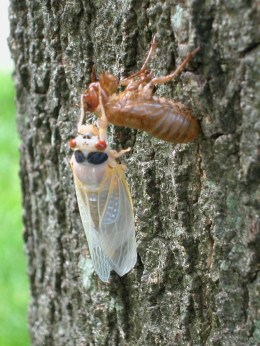
Cicadas Emerge in Eastern USA
Brace yourself. Over the next few weeks, an estimated 30 billion to 1 trillion cicadas will emerge from 17 years of underground existence and noisily take flight along the Eastern seaboard, the Associated Press reports.
Subsisting on tree sap, the 1-inch, wingless male cicada nymphs will crawl out of holes the size of pinky fingers once the ground temperature reaches 64 degrees, then molt into adults, reports NBC Nightly News. With newly developed wings, male cicadas perch on tree branches and sing, individually or in a chorus, until a female approaches. The ladies’ presence prompts the dudes to sing a new tune, do a dance and mate. Male mating calls can reach 100 decibels, about as loud as a rock concert. They are so noisy, “you don’t hear planes flying overhead,” Gene Kritsky, an entomologist at the College of Mount St. Joseph in Cincinnati remarked once when she measured their loudness in 2004.
But what cicadas have in bark, or more aptly, buzz, they lack in bite—saplings or young shrubs will bear the brunt of any damage. “It’s not like these hordes of cicadas suck blood or zombify people,” May Berenbaum, a University of Illinois entomologist tells the Associated Press.
(MORE: Sixteen Ways to Eat a Cicada: The Fine Art of Insect Cuisine)
After mating, females lay eggs in bulk in order to ensure progeny—around 600 eggs each and more than enough to go around for predator birds. The spawn eventually fall to the ground and burrow into the earth and cycle through molting stages until another re-emergence in 17 years. The next debut isn’t slated until 2030. “These guys have evolved several mathematically clever tricks,” University of Maryland entomologist Mike Raupp told the Associated Press. “These guys are geniuses with little tiny brains.”
Most cicadas emerge annually. But the ones surfacing this year are called magicicadas or Brood II. This red-eyed variety is found in the eastern states, from North Carolina to Connecticut, with some areas affected more than others. For example, Staten Island will hear them loud and clear, but the rest of New York City and Long Island won’t, Chris Simon of the University of Connecticut tells the Associated Press. Residents of Baltimore, Philadelphia and Washington, on the other hand, should expect a veritable cicadian cacophony.
Still more intrigued than revolted? RadioLab has launched a Cicada Tracker to document sightings as these cicadas begin to emerge in full force.
MORE: Beepocalypse Redux: Honey Bees Are Still Dying—and We Still Don’t Know Why






